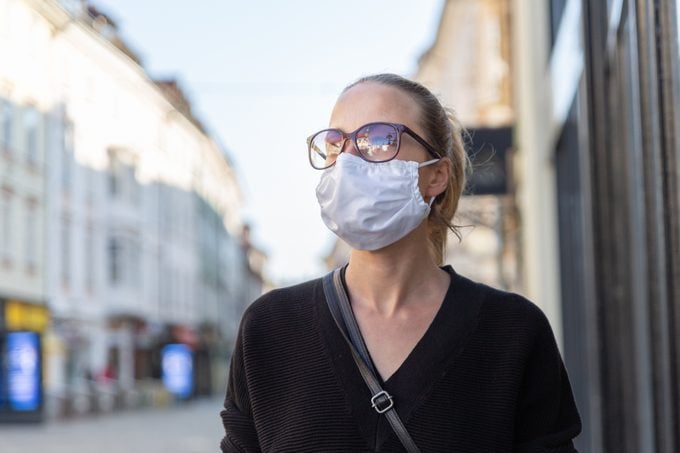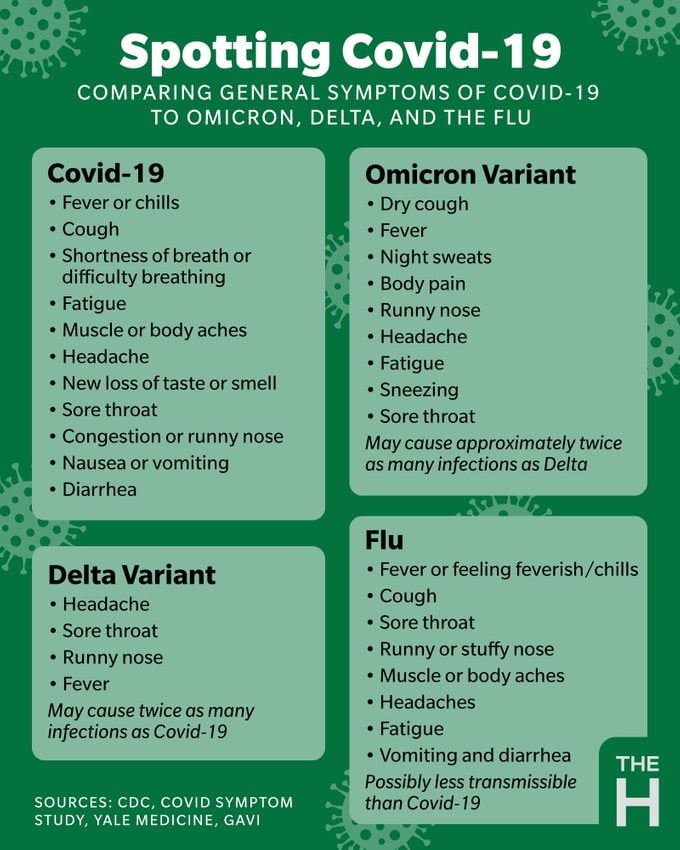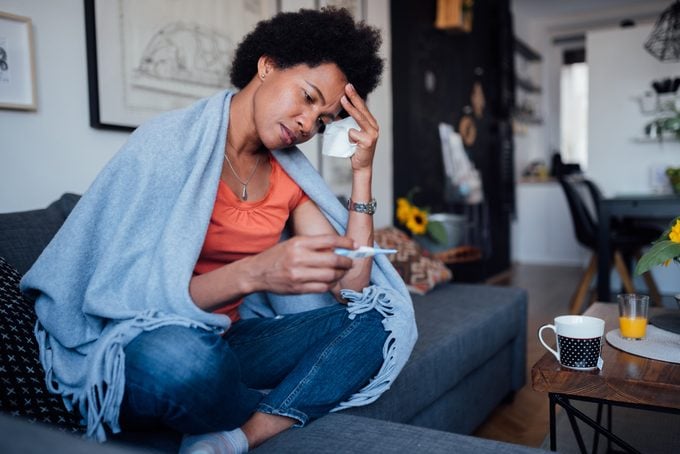15 Signs of COVID That Could Mean You Were Sick but Didn’t Know
Updated: Apr. 07, 2023
By now, we've all known someone who's had COVID-19. With the two most dominant variants now significantly more contagious than their parent, Omicron...have you been infected without realizing it? Here are subtle signs of COVID that may suggest this.
Signs of COVID can be tough to discern. As of December 2022, about half of Americans reported that they’d been infected with COVID-19 at least once, according to the most recent data from the ”State of the COVID-19 Pandemic” report (which is developed in collaboration between Harvard, Northeastern, Rutgers, and Northwestern universities). However, in reality, that number is probably much higher: almost half of likely COVID-19 cases are going undiagnosed and unreported in the US, the study authors noted.
The COVID underreporting is not only an issue in the United States. According to the World Health Organization COVID Dashboard, as of February 3, 2023, there have been 754,018,841 confirmed cases of COVID-19 worldwide, including 6,817,478 deaths. But that’s just the official numbers. If you look at “excess deaths”—the number of deaths that have been reported above what is usual—COVID-19 is likely responsible for about 20 million deaths worldwide, which would indicate billions of unconfirmed cases, according to an artificial intelligence model from The Economist.
This is one of the hardest truths of this pandemic: Accurate numbers about COVID-19 infections are hard to come by, partly because testing is spotty and it’s hard to know for sure if you’ve had it without testing, says George Jour, MD, a pathologist and clinical professor at NYU Grossman School of Medicine and an advisory board member and clinical consultant at Innovative Health Diagnostics, a company that does COVID-19 testing.
And by this point, who hasn’t wondered if that recent stuffy nose, sore throat and headache was the flu, a cold, or could it have been COVID-19? If you’ve felt a little “off” in recent months but didn’t know quite what was going on, here are possible silent signs that you may have been infected with COVID-19—and what that means for you now.
This Smart COVID Test Should Be on Your Radar, a Health Reporter Says
New highly contagious variants mean many more infections but even less testing
Currently, the dominant COVID-19 variant in the US is XBB.1.5, with 66% of cases, followed by BQ.1.1, with 20% of cases. These two variants are many times more contagious than their parent, Omicron, which was far more contagious than the original strain. So if you think you haven’t had it yet, there’s a much higher chance that you will get infected soon—especially as there doesn’t seem to be much protection from these new variants from previous COVID-19 infections and vaccinations. (Although it’s still important to get the bivalent booster shot, Dr. Jour says.)
“These variants are highly contagious, but slightly less symptomatic—which means that more people are getting sick, but less people are recognizing it and even less are testing for it,” says Dr. Jour.
Plus, he adds, more people are using at-home rapid antigen tests, which can give a false negative result, leading people to believe they don’t have COVID-19 when they actually do. “PCR tests are the most reliable for people with or without symptoms and are still considered the gold standard, given their high sensitivity—but people are less likely to seek those out because they’re less convenient and accessible,” he says.
Fortunately, the effects of the new variants are much the same as previous variants’. You can still use them to gauge whether it’s possible you’ve had the infection.

Sign of COVID-19: You’ve got natural antibodies
Matthew B. Laurens, MD, MPH, a professor of pediatrics at the University of Maryland School of Medicine in Baltimore, says no one is recommending routine antibody testing to see if you have had COVID-19 or have mounted a response to the COVID-19 vaccines at this time. However, these tests are available. “There is an antibody test that can tell you if you have been exposed to natural infection, and there is a different antibody test that looks at response to the COVID-19 vaccine,” Laurens explains.
Specifically, antibodies to nucleocapsid protein only appear if you have recovered from COVID-19, while vaccines and natural infection produce an antibody to spike proteins. “If you are positive for antibodies to the spike protein and negative for antibodies to nucleocapsid protein, you have been vaccinated, but not exposed,” he says—adding: “If you are positive for both, you have had COVID-19 and you may or may not have been vaccinated.”
There is still a lot research is discovering about antibodies, including how long they last and what level is considered most protective…or, for how long.
Sign of COVID-19: You were feeling rundown a few months back
Fatigue is a common symptom—and lingering effect—of COVID-19. But for those of us with busy lives (that’s just about everyone!), sometimes it’s simply hard to tell typical tiredness from something more serious. “If you didn’t feel sick enough to consider getting tested, you could have had COVID-19 and recovered without an official diagnosis.”
Screenshot our infographic to reference anytime:

Sign of COVID-19: Brain fog
Changes related to the brain—undiagnosed or uncharacteristic depression, confusion or trouble focusing, as examples—are pervasive Covid-19 symptoms that haven’t gotten a great deal of attention. Read What Is COVID-19 Brain Fog—and How Do You Get Rid of It?
Sign of COVID-19: Your fever and cough weren’t the flu
You had a fever for days, a hacking cough, and were exhausted, but your flu test was negative. That could have been a sign of COVID-19, says Adam Spivak, MD, an infectious disease doctor at the University of Utah in Salt Lake City, noting that flu season and the COVID-19 pandemic overlapped.
Starting in late 2021, healthcare professionals were seeing cases of flurona. “If you weren’t tested at the time, or you were negative for other tests such as the flu, it could have been COVID-19,” Spivak says. “There is so much overlap with colds or flu and coronavirus symptoms, which is why testing for COVID-19 has been so emphasized.” (We’ve broken down the flu vs. coronavirus symptoms here.)
Sign of COVID-19: You suddenly lost your sense of smell or taste
You’ve heard this: Loss of sense of smell or taste is a hallmark of Covid-19 infection with earlier variants. What you may not know is that these symptoms are not a slam dunk by any stretch, says Benjamin Singer, MD, an assistant professor in pulmonary and critical care at Northwestern University Feinberg School of Medicine in Chicago.
Sign of COVID-19: Your hair is falling out in clumps
If you’re noticing hair loss, it could be due to a past infection with COVID-19, says Alexis Young, MD, a dermatologist at Hackensack University Medical Center in New Jersey. “This phenomenon is known as telogen effluvium and occurs when physical or psychological stress causes hair roots to be pushed into a resting state prematurely,” Dr. Young explains. “It’s not specific to COVID-19, but I am seeing lots more of it among people who are recovering from COVID-19, including some who may not have known they were infected in the first place.”
The good news is that your hair will likely come back. “Hair follicles aren’t permanently damaged with telogen effluvium,” this dermatologist says. “Shedding can continue up to six months, and full recovery can take up to 18 months because hair grows back so slowly.”
Sign of COVID-19: You’ve got hives
Post-COVID-19 hives are a phenomenon health professional have observed, Dr. Young says. “We are also seeing viral exanthems, which is a skin rash that is often related to a viral infection after COVID-19.”
These seem to be more common in children than adults and can even occur if you didn’t have any noticeable COVID-19 symptoms. These hives and rashes usually resolve on their own with judicious use of moisturizer or topical steroids, if the itch is particularly bothersome.
Sign of COVID-19: Your loved ones were infected
If COVID-19 passed through your house taking no prisoners except you, it’s possible you were infected and didn’t realize it. Many people who are infected with this virus have mild or no symptoms, and Omicron reportedly produces even milder symptoms than other variants—especially among people who are vaccinated or boosted, says Dr. Len Horovitz.
Sign of COVID-19: You just didn’t test at the right time
It’s possible you missed the infection even if you were tested, Horovitz says. “Any test you take is snapshot of the past 12 to 24 hours, and you can’t extrapolate from a single test,” he says. “Depending on when and how you tested, you may not have caught the infection.” At-home COVID-19 antigen tests aren’t that sensitive either, so you may have received a false negative.
Sign of COVID-19 Your toes were affected
“COVID toes” can happen, Dr. Singer says. COVID toes are marked by purple or red, itchy wounds. “Skin manifestations, particularly of the toes, could be something that makes people who weren’t tested look back and say, ‘Was that a manifestation of COVID-19?'” he says.
He cautions that toes with this appearance aren’t a sure sign of COVID-19, as there could be other causes. If you have questions, talk to your doctor.

Sign of COVID-19: Your stomach was acting up
Covid-19 is a respiratory illness, but not everyone coughs or gets short of breath. For some, diarrhea may be the only sign of infection, Dr. Horovitz says.
If you have digestive symptoms such as diarrhea, nausea, or vomiting and were in contact with individuals infected with COVID-19, you should have a higher index of suspicion, he says. (Also, these remedies for diarrhea may help.)
Sign of COVID-19: You had a stroke out of the blue
There’s a link between COVID-19 and stroke risk, even among younger patients. Here’s what doctors and researchers know so far about stroke risk and coronavirus.
Also, here are the warning signs of stroke, and what to do if you suspect a stroke.
Sign of COVID-19: You have pink eye
Pink eye infection, or conjunctivitis, may be a sign of coronavirus—but this has been relatively rare, according to the American Academy of Ophthalmology. If you develop pink eye, don’t panic. “Call your ophthalmologist to let them know and follow their instructions for care,” the Academy suggests.
Sign of COVID-19: You’ve got cotton mouth
Is your dry mouth a symptom of COVID-19?
Maybe. As many as 40% of people with COVID-19 may experience symptoms of dry mouth during or after the illness, according to a study in the Journal of Dental Research. Also, 2021 in the journal Nature Medicine provided clues as to how COVID-19 affects the mouth and saliva.
Researchers from Wellcome Sanger Institute in Cambridge, U.K. and other organizations in the U.S. and U.K. identified the angiotensin-converting enzyme 2 receptor, or ACE2 receptor, in cells of the salivary glands and tissues lining the mouth. This is the protein that SARS-CoV-2 locks into for entry into the body.
They also found that the virus can multiply in the cells of your salivary glands.
Sign of COVID-19: You’re experiencing “phantom smells”
Some people recovering from COVID-19 report that they constantly smell smoke, garbage, or even skunk-like odors that aren’t really there. These phantom smells tend to become more common over time, with recent figures suggesting that about 25% of people experienced these otherwise unexplainable smells soon after diagnosis, according to the preprint server medRxiv. (This information has not yet been peer-reviewed.)
How to prevent COVID-19 infection
There is still a huge role for prevention, Horovitz says. “Get vaccinated and boosted when you are able to,” he says. “Wear masks when inside public spaces and places and practice social distancing.” (Here’s why you still need to wear a mask indoors if you’re vaccinated.)
Also be sure to wash your hands with soap or water before, during, and after preparing food or eating. Also wash after caring for someone at home who is sick, treating a cut or wound, going to the bathroom, changing diapers, blowing your nose, coughing, or sneezing. If a sink isn’t available, use a hand sanitizer that contains at least 60% alcohol.
- What New York’s Laundry Detergent Ban Means for Some Popular Brands
- There’s a Link Between Ovarian Cancer & 2 Common Medications
- This Is the Best Diet for Your Heart, Says New Report
- I Took Magnesium to Help Me Sleep for a Month—Here’s What Happened
With additional reporting by Charlotte Hilton Andersen
